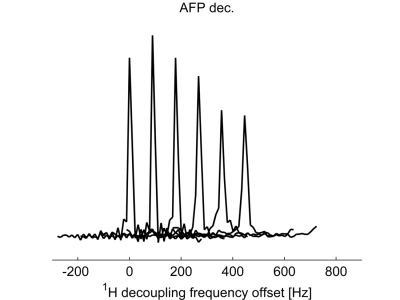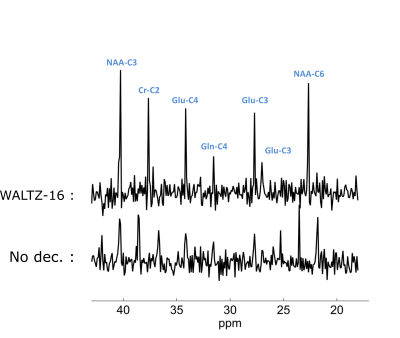3880
Evaluation of three different broadband ¹H decoupling techniques for 13C-MRS at high field using double-tuned array coils1Laboratory for Functional and Metabolic Imaging (LIFMET), Ecole Polytechnique Fédérale de Lausanne, Lausanne, Switzerland, 2Department of Radiology, University of Lausanne, University of Geneva, Lausanne, Geneva, Switzerland
Synopsis
synopsis
Introduction
13C-MRS is a powerful tool to assess non-evasively the human metabolism. However, this technique has a very low sensitivity, which remains a major drawback for human studies. Pulse sequences including polarization transfer and 1H decoupling can be used together with highly sensitive RF-coils to strongly increase its SNR. It has been recently proposed to used double-tuned array coils for human brain 13C-MRS at high field1,2. In this study, we intended to evaluate the performance of three widely-used broadband decoupling schemes to determine which were more appropriate for double-tuned array coils at 7T.Methods
Coil design: A 4-channel 13C - 4-channel 1H phased array coil1 was used to perform high sensitivity 1H decoupled 13C-MRS at 7T (fig.1). Central features of this double-tuned array coil are : 1) high sensitivity at 13C frequency over a large FOV (posterior half of the brain) ; 2) high transmit efficiency (B2/SAR10g) and homogeneous excitation at 1H frequency ; 3) strong isolation between 1H and 13C channels.
Decoupling scheme: Broadband decoupling performances were compared for two different composite pulse schemes and one adiabatic pulse scheme. The composite schemes were the WALTZ-16 3 (RR’R’R, with R=270-x360x180-x270x90-x180x360-x180x270-x, R’ : phases reversed) and the MLEV-16 4 (RRR’R’R’RRR’R’R’RRRR’R’R, with R=90x180y90x). Adiabatic decoupling was performed using a train of adiabatic full passage (AFP) pulses, arranged in a 20-step phase supercycle 5 (called 5-STEP and MLEV-4 : RRR’R’, R=(0o,60o,150o,60o,0o)).
MR measurements: MR experiments were performed on a 7T human scanner (Siemens, Erlangen, Germany). First and second order shims were adjusted using FASTMAP6. Glucose $$$\beta$$$ C1 resonance from a 4x4x4cm3 VOI in a 4L phantom (12mM Glc-C1, 13C-labelled) were acquired using direct excitation (ISIS localization, 6ms 90o BIR-4, δ13C=96.6ppm, δ1H=4.63ppm, TR=7s, 32avg., acq. duration=102ms). B2 was calibrated using 500us square pulses in a 1x1x1cm3 volume in the center of the VOI. Decoupling was performed during the whole signal acquisition. $$$\gamma B_2 /2 \pi$$$ was set to 500Hz for the composite pulses and 530Hz for the 4ms AFP pulses to maintain equal energy deposition for the three schemes. Decoupling bandwidths were evaluated by decrementing the 1H decoupler offset in 90Hz steps from 0Hz to -630Hz (ie, at 7T, 0.3ppm steps from 4.63ppm to 2.53ppm). Increased sensitivity and spectral simplification resulting of broadband proton decoupling use was then assessed by measuring 13C resonances of a non-labelled 4L phantom containing four major brain metabolites in natural abundance concentration range7 ( 15mM NAA, 10mM Glu, 8mM Cr and 5mM Gln). Signal from a 6x6x6cm3 VOI was localized on 1H spins using 3D-ISIS. A semi-adiabatic version of DEPT8 (J=130Hz, δ13C=40.3ppm, δ1H=2.4ppm, αy=45o (optimal for CH2 detection), TR=5s, 192avg.) was used to transfer polarization from 1H to 13C. SAR was maintained within FDA guidelines.
Results and discussion
For $$$\gamma B_2 /2 \pi$$$=500Hz, composite
pulses WALTZ-16 and MLEV-16 were more efficient than AFP 5-STEP MLEV-4 over the whole range of
1H frequencies (fig.2-3-4). MLEV-16 provided slightly higher decoupling efficiency at the
resonant frequency than WALTZ-16. Both frequency profiles were flat over 900Hz
bandwidth. At the plateau’s edges, MLEV-16 performance dropped faster than
WALTZ-16, which stays above 90% until ~530Hz. Therefore, WALTZ-16 was considered
as the most suitable scheme among the three that were tested with the double-tuned
array coil. It is known that WALTZ-16 intrinsically performs better
off-resonance than MLEV-16, although it suffers more of B2 inhomogeneity7.
However, the B2 field of array coils is more homogeneous than linear
coils, which compensate for this effect.
Natural abundance non-labelled 13C-MRS benefits significantly of broadband decoupling (fig.5). All resonances between 40 and 20 ppm are clearly resolved and distinguishable when WALTZ-16 1H decoupling is applied, allowing a much more reliable labeling. Moreover, without 1H decoupling, Gln (5mM) resonances were not discernible from noise.
Conclusion
WALTZ-16 is particularly well-suited for broadband 1H decoupling of 13C-MRS experiments with double-tuned array coils at high-field. It can be applied with these coils within the FDA guidelines for SAR to greatly enhance the sensitivity. It allows quick detection of low concentration metabolites (~5mM) in about ten minutes. Ongoing in vivo experiments are revealing that the combination of high sensitivity coil together with efficient decoupling is indeed crucial for low concentration metabolite detection in human brain.Acknowledgements
Supported by Centre d'Imagerie BioMédicale (CIBM) of the UNIL, UNIGE, CHUV, EPFL and the Leenaards and Jeantet Foundations.References
1. Donati G et al. 8-Channel Double Tuned 13C-1H Transceiver Phased Array for 13C MRS in Human Brain at 7T. Proceedings of ISMRM 23rd Meeting (Toronto), 2015.
2. Donati G et Gruetter R. Feasibility of localized, 1H decoupled natural abundance 13C-MRS of human brain at 7T using double tuned array coils and polarization transfer. Proceedings of ISMRM 25th Meeting (Honolulu), 2017.
3. Shaka AJ et al. Evaluation of a new broadband decoupling sequence: WALTZ-16. Journal of Magnetic Resonance. 1983 Jun 15;53(2):313-40.
4. Levitt MH et al. Supercycles for Broadband Heteronuclear Decoupling. Journal of Magnetic Resonance. 1982 Jun;50:157-160.
5. Kupce E et Freeman R. Stretched Adiabatic Pulses for Broadband Spin Inversion. Journal of Magnetic Resonance 1995 Jul;117:246-256.
6. Gruetter R. Automatic, localized in vivo adjustment of all first and second-order shim coils. Magnetic Resonance in Medicine. 1993 Jun 1;29(6):804-11.
7. de Graaf RA. in vivo NMR Spectroscopy : Principles and Techniques, Second Edition, Wiley 2013
Figures




